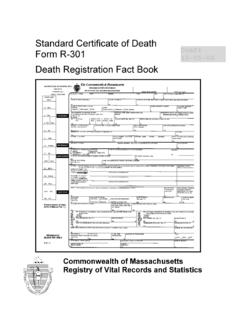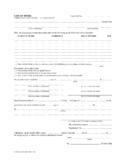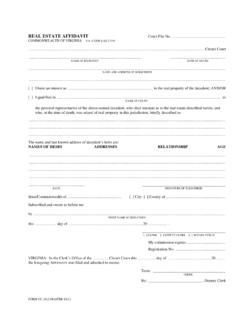Transcription of Front of Form R-301 - fcaemass.org
1 Standard Certificate of DeathForm R-301 Death Registration Fact Book Commonwealth of MassachusettsRegistry of Vital Records and StatisticsDraft10-05-06 RVRS Fact Book for Death RegistrationForm R-301 Draft 10/05/2006 Table of ContentsIntroductionPg 3-5 Chapter 1Pg 6 - 9 Creating Death RecordsChapter 2Pg 10 Examining and Registering Death RecordsChapter 3Pg 11-13 Disposition/Removal PermitsChapter 4Pg 13-36 Completing the Massachusetts Standard Certificate of Death -- Items 1 through 43 Chapter 5Pg 37 Certified CopiesChapter 6Pg 38 Report of Fetal DeathChapter 7Pg 39 Pending Investigation of DeathAppendix APg 40-55 Statutes Relating to Death Registration and Removal Permits in Massachusetts. Chapter 38 Chapter 46 Chapter 111 Chapter 114 Chapter 4 Appendix BPg 56-62 Sample Death Forms Standard Certificate of Death ( R-301 ) Pronouncement of Death (R-302) Burial Permits (R-309) Draft Medical Examiner Certificate of DeathAppendix CPg 63-64 Contacts for Death Registration Information2 RVRS Fact Book for Death RegistrationForm R-301 Draft 10/05/2006 IntroductionPURPOSEThis manual provides instruction for all individuals who participate in the death registration process in the Commonwealth of Massachusetts.
2 The death registration system provides uniform guidelines for completing the Standard Certificate of Death. Background information is included on the importance of individual elements of these documents for legal and statistical purposes and specific instructions for recording death OF DEATH REGISTRATIONA death certificate is the permanent legal record of the fact of death of an individual. As a permanent legal record, the death certificate is extremely important to the decedent s family. It is also needed for a variety of medical and health-related research death certificate provides important information about the decedent, such as age, sex, race, date of death, his or her parents, and if currently or previously married, name of the spouse; information on circumstances and cause of death; and immediate disposition. This information is used in the application for insurance benefits, settlement of pension claims, and transfer of title of real and personal property.
3 The certificate is considered to be prima facie evidence of the fact of death. It can be introduced in a court of law as evidence when a question about the death arises. As a service to the decedent s family, the funeral director should prepare the best death record possible. This responsibility makes the funeral director the backbone of this country s death registration data from death certificates are used to identify public health problems and measure the results of programs established to alleviate these problems. These data are a necessary foundation on which to base effective public health programs. Health departments could not perform their duties without such statistics are of considerable value to individual physicians and to medical science because they can be used to identify disease etiology and evaluate diagnostic techniques. Demographers use mortality statistics in combination with natality statistics to estimate and project population sizes, which are important in forecasting and program planning.
4 Because the information derived from death certificates can be no more accurate than the data on the certificate, it is very important that all persons concerned with the registration of deaths strive not only for complete registration but also for accuracy and promptness in reporting these Fact Book for Death RegistrationForm R-301 Draft 10/05/2006 STATE RESPONSIBILITYThe responsibility for the preparation of the reporting form as well as the enforcement of all laws relative to death registration falls upon the Registrar of Vital Records and Statistics of the Massachusetts Department of Public Health. The Registrar s office is located on the First Floor, 150 Mt. Vernon St., Dorchester, MA 02125. Any questions regarding death registration should be directed to the Registry at (617) 740-2622. A contact sheet for the Registry staff is included as an appendix to this RESPONSIBILITYThe responsibility at the local level is two- local board of health or its authorized agent receives a satisfactory certificate of death from the funeral director and issues a proper burial permit.
5 It is of the utmost importance that the board of health officer examines the certificate carefully to ensure its proper completion in accordance with uniform guidelines. The board of health agent then transmits the certificate to the city or town clerk for responsibility of the local clerk is to examine the certificate for any errors or omissions; upon acceptance, to record the certificate of death in the official records of the community. At the appropriate time, the original record is transmitted to the State Registry of Vital Records and Statistics, and a true copy attest to the community of residence. If applicable, a true copy attest is also sent to the community where burial took place if the decedent was a war DIRECTORS RESPONSIBILITIESF uneral directors are responsible for obtaining the death certificate from the certifying physician or medical examiner; completing the personal data items on the deceased; and filing a completed certificate with the local board of health or its agent in the city or town where the death occurred in order to obtain a burial permit.
6 In summary, the duties of a funeral director in regard to death registration include: Obtain the certificate from the certifier with item numbers 29 through 40 completed as well as item numbers 1 through 5 on the reverse side of the certificate. Complete all personal data items on the deceased (item numbers 1 through 22). Never leave an item blank. If it is unknown, enter either dashes or Unknown. If it is not applicable such as occupation for an infant, complete the space with dashes for each individual question. Use permanent black ink only; no strikeovers, erasures or use of liquid whiteout. File a completed death certificate with the local board of health or their authorized agent in order to obtain a burial permit prior to disposition. Notify the medical examiner of any death that is believed to have been due to violence or in any case outlined on the reverse side of the standard certificate of death under Referral to the Office of the Chief Medical Examiner (OCME) unless this has been previously done by the certifying physician.
7 Assist state and local officials by answering inquiries promptly and call the State Registrar s office for advice or assistance when necessary. See the Contact List in this Fact Book for Death RegistrationForm R-301 Draft 10/05/2006 CHAPTER 1 Creating death recordsAll vital events have four basic individuals or entities involved in the creation of the record. For death records the responsibilities are as follows:Subject of the RecordDecedentInformantSpouse or heirs at law (in most cases)CertifierPhysician or Medical ExaminerFacilitatorFuneral DirectorInformant (Spouse, Heirs at Law, Executor, Etc.)Within the statutes on registering and creating a vital record, there is no specific legal definition of the informant in the death registration process. However, in other sections of the law, the informant is defined as the "spouse or heirs at law." The informant may also include the executor, a family friend, etc. The informant is responsible for providing the personal information to the funeral director.
8 The informant has no responsibility for the medical decedent, however, cannot be the sole informant. In this time of prearrangements, a number of funeral directors may attempt to list the decedent as the informant. If the decedent is listed as the informant, some other individual (this could be the funeral director) must also be included as the informant). The reason that the decedent cannot be the informant alone is that some information such as residence and marital status may change up until the time of (Pronouncing Registered Nurse, Physician Assistant, Nurse Practitioner, AND Physician and/or Medical Examiner)The certifier initiates the death certificate process. If the facts of the death meet the criteria the initiation may be with a Pronouncement of Death Form (R-302). The certifier, in all cases, must be a physician (Medical Doctor or Doctor of Osteopathy). Although there appears to be no place in Massachusetts statutes that explicitly require a pronouncement of death, prior to any type of removal of a decedent, Section 9, chapter 46, , lists as one of the physicians able to complete the medical certification on a death certificate, the physician declaring such person dead.
9 Further, this same section of the law allows registered nurses, physician assistants, and nurse practitioners in some limited cases to make a pronouncement to allow for removal of the remains. MGL c. 38, 6 allows for removal of a decedent upon a telephone request of the police chief to the medical examiner (or in some limited cases to the district attorney) in cases where there is medical examiner jurisdiction). The physician completing the certificate falls into one of 5 RVRS Fact Book for Death RegistrationForm R-301 Draft 10/05/2006 three broad categories as stated in the physician (or a physician covering for the attending physician). The definition of attending physician is somewhat vague. A decedent may, in fact, have several physicians who consider themselves "attending physician." For example, if an individual is hospitalized for cardiac surgery dies while in the hospital, the cardiac surgeon, the referring cardiologist or his primary care physician may all consider themselves attending physician?
10 For purposes of certifying the facts of death, any of the three would be highly acceptable, as they should have sufficient information regarding the patient's history to complete accurately the cause of death declaring an individual dead or a hospital medical officer. In cases where the certifying physician is not the attending physician, the name of the attending physician is included on the death certificate. This provides a relatively easy mechanism for later amendment of the certificate with more complete information if necessary by the attending (and all others including pronouncers. funeral directors. hospital, personnel. boards of health, clerks. etc.) are required to refer to medical examiners for certification all of the categories of where criminal violence appears to have taken place, regardless of the time interval between the incident and death, and regardless of whether such violence appears to have been the immediate cause of death, or a contributory factor by accident or unintentional injury, regardless of time interval between the incident and death, and regardless of whether such injury appears to have been the immediate cause of death, or a contributory factor thereto; , regardless of the time interval between the incident and death; under suspicious or unusual circumstances; following an unlawful abortion; relating to occupational illness or injury; in custody, in any jail or correctional facility, or in any mental health or mental retardation where suspicion of abuse of a child, family or household member, elder person or disabled person exists.





